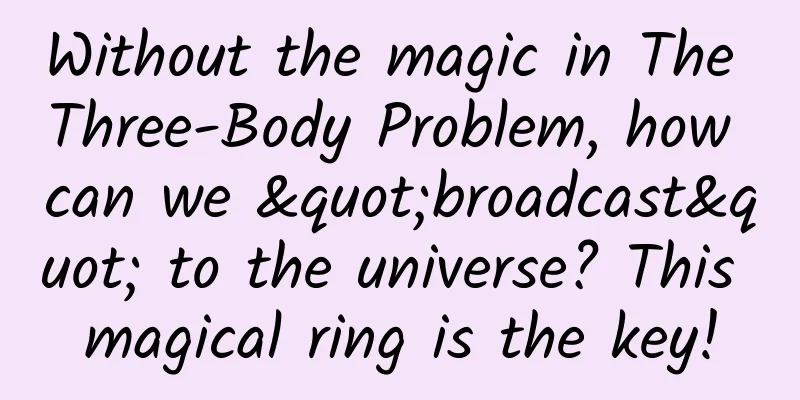Without the magic in The Three-Body Problem, how can we "broadcast" to the universe? This magical ring is the key!

|
This year, the science fiction novel "The Three-Body Problem" was finally adapted into a TV series, giving fans of the novel a good time. In the novel, there is a plot in which Ye Wenjie uses the sun to amplify the signal sent by the Red Coast Base, so that the signal can be received by the Trisolarans. In the real world, scientists do not yet have Ye Wenjie's magic, and cannot use the sun to broadcast signals from the earth to the entire universe. Is there no other solution? Yes. There is a way to use the sun to amplify the signals we send and receive. This story begins with a famous solar eclipse observation more than a hundred years ago. 1. Does gravity deflect light? Observations of the 1919 total solar eclipse confirmed this! In 1916, Einstein published the theory of general relativity, which overturned Newton's description of gravity, abolished the traditional concepts of space and time, and thus built a completely new framework for physics. In general relativity : gravity causes the curvature of space-time, so light will also bend under the influence of gravity . Einstein calculated that the sun's gravity deflects light by only 1.75 arc seconds . Soon, British astronomer Dyson realized that the total solar eclipse on May 29, 1919 would provide an excellent opportunity to measure the deflection of light caused by the sun's gravity, thereby testing Einstein's prediction . During the total solar eclipse, the Sun was in front of the bright Hyades (a cluster of stars gathered together by gravity). At the time of the eclipse (when the Sun was completely covered), many bright stars in this cluster could be observed. In this way, by comparing the positions of the stars at the time of the eclipse with the positions when the Sun was not in this area, we can know whether the light is bent by the Sun's gravity and how much the deflection angle is. There are many stars in the star cluster, and the more star positions they measure, the lower the error can be. Then, they developed a detailed observation plan: Dyson remained in England as the overall director. Eddington and his team went to Principe in West Africa. Their team had bad luck and encountered cloudy weather, but they still took 16 negatives. Crommelin led another team to Sobral in northern Brazil. The weather conditions in Brazil were better at the time, but their equipment had some problems, and many of the negatives they took were not clear. Fortunately, they used a backup device to observe at the same time, and finally found that the observation results of the backup device were more critical (Figure 1). In November of that year, at a special meeting jointly held by the Royal Society and the Royal Astronomical Society in London, they collectively announced the measurement results, which were very close to Einstein's predictions, verified the general theory of relativity, and then became global news (Figure 1). Figure 1: News about the total solar eclipse observation results in the London Illustrated News on November 22, 1919. Below: The negative film taken in Sobral, Brazil, restored by the European Southern Observatory 100 years later, with yellow circles marking nearby stars. (Source: https://cseligman.com/text/sky/eddington.einstein.htm) 2. Einstein Ring : The phenomenon caused by the deflection of light by gravity Gravity bends light, which is similar to placing a lens in front of a light source, so it is also called the "gravitational lens" effect. If a distant celestial body, a lens object (a celestial body with very large mass) and the earth are exactly in a straight line, and the distances between the three are just right, so that the "refracted" light observed on the earth converges together, the image formed is a ring, which is called an " Einstein ring " . We have indeed seen many Einstein rings in astronomical observations, such as Figure 2. The bright yellow galaxy in the center is the lens object, and the surrounding blue rings are the more distant galaxies that are "refracted". The lens object is like an optical lens, which magnifies the brightness and size of distant celestial bodies. However, in fact, this is just a phenomenon of light deflection due to gravitational effects. Figure 2 Einstein rings produced by the gravitational lensing effect of different galaxies captured by the Hubble Telescope. (Image from NASA/ESA/A. Bolton/SLACS Team) 3. Amplify the signal ? Place a telescope 550 AU from the sun → The sun is the closest massive celestial body to us, accounting for more than 99.8% of the mass of the solar system. Observations more than 100 years ago have confirmed that the sun can bend light, and the deflected light converges to a point where it receives much more light than the original light. Therefore, we can use the Sun as a lens object to amplify the signals from distant objects behind the Sun. The sun's gravity can also produce Einstein rings. How can we observe them? (Review the conditions for observing Einstein rings mentioned above) 1. The distant celestial body behind the sun, the sun ( lens celestial body ), and the telescope should be in a straight line ; 2. The farther the telescope is from the sun , the larger the diameter of the observed Einstein ring will be. Only when the Einstein ring is larger than the diameter of the sun can it be observed by us. So, how can we make the Einstein ring larger than the diameter of the sun? There is a key parameter here - the minimum distance between the telescope and the sun. On the line connecting the distant celestial body, the sun and the telescope, Einstein rings can be observed at positions farther than this minimum distance (see Figure 3). According to calculations, the minimum distance of the telescope from the sun is about 550 astronomical units (one astronomical unit is the distance from the earth to the sun), which is equivalent to 14 times the distance from Pluto to the sun. The farthest probes currently flown by humans are Voyager 1 and 2, which have been flying for more than 40 years and have only flown about 150 astronomical units. Figure 3 Schematic diagram of Einstein rings caused by the solar gravitational lens effect. The orange square is the minimum distance at which Einstein rings can be seen, which is about 550 AU from the sun. The orange dotted line represents the focal line of the gravitational lens, and Einstein rings can be seen on this line (Source: created by the author) The area of the Einstein ring observed here and the wavelength of the signal determine how many times the signal can be amplified. The area of the Einstein ring depends on its diameter and width, and its width is the aperture of the telescope. Therefore, the larger the aperture of the telescope and the farther away it is, the more the signal will be amplified . For example, if a 1-meter telescope is placed at a distance of 600 AU, the Einstein rings observed can amplify the infrared signal by billions of times! If we replace this telescope with a signal transmitter and send a signal toward the sun, then in the opposite direction, the Einstein rings generated by the sun's gravity can also be observed at a distance of more than 550 AU, and the signal can be amplified billions of times accordingly. However, the coverage area of the amplified signal is very small - less than one square arc second, like an extremely narrow beam of light. Only the telescope within this beam can detect the amplified signal. Therefore, if we want to use the sun to amplify the signals sent to the Trisolarans, or to monitor the signals from the Trisolarans, we need to place a transmitter or telescope on the line connecting Alpha Centauri (the prototype of the Trisolarans' home planet) and the sun , 550 astronomical units away from the sun. This can greatly save the power needed to transmit signals, or monitor weaker signals . Of course, we have not yet found any signs of life on the planets of Alpha Centauri, let alone alien civilizations. 4. Keep moving forward towards the dream of interstellar Internet! Placing a transmitter or telescope at such a long distance is indeed a very challenging task for current aerospace technology. But it does not prevent scientists from conducting conceptual research. As early as 1979, astronomer Eshleman proposed that the solar gravitational lens effect could be used for interstellar communication. In 1993, Italian astronomer Maccone proposed a conceptual project called "FOCAL" to the European Space Agency, which was to launch a spacecraft to 550 astronomical units to use the solar gravitational lens effect to monitor the communications of extraterrestrial civilizations. He subsequently wrote many papers and a monograph to discuss and improve this project. In 1999, West of the Jet Propulsion Laboratory detailed in a paper a NASA-funded conceptual study called the "Solar Gravitational Telescope" to explore the feasibility of using the gravitational lensing effect of the sun for astronomical observations. In recent years, NASA's Innovative Advanced Concepts program (NIAC) has continuously funded a project to use solar gravitational lensing to image exoplanets. We can not only use the sun, but also other stars as gravitational lenses to amplify the signal . In the future, we humans will send probes to visit the planets of Alpha Centauri. The data from the probes can be amplified by their stars and transmitted back to the solar system, and then received after being amplified by the sun. In the more distant future, when we realize interstellar travel and explore the vast universe, we can establish information transmission nodes on the focal line of the gravitational lens of the star, and use the stars to build a communication network across galaxies, just like the interstellar Internet! References: 1. https://arxiv.org/pdf/1912.05587.pdf 2. https://arxiv.org/pdf/1706.05570.pdf 3. https://arxiv.org/pdf/2009.01866.pdf Author : Yan Zhen, researcher at Shanghai Astronomical Observatory, Chinese Academy of Sciences Planning: Zhai Guoqing Produced by: Science Popularization China Produced by: China Science and Technology Press Co., Ltd., China Science and Technology Publishing House (Beijing) Digital Media Co., Ltd. |
<<: "Air taxis" are here! Can we take a flying taxi when we go out in the future?
>>: Want to show off your grapefruit diet? Don’t be blind, listen to what the experts say
Recommend
The moon is shrinking all the time. Will it shrink into the size of a raisin?
Produced by: Science Popularization China Author:...
If you want to reduce adverse reactions when taking aspirin for a long time, what should you do?
Aspirin is the most classic antiplatelet drug, wh...
Android phone fluency ranking: Xiaomi fifth, OnePlus first, where is Huawei?
As we all know, mobile phones are divided into tw...
What impact does big data have on mobile app development?
"What kind of application is a great applica...
WeChat’s turnaround is harder than an elephant
Zhang Xiaolong, the "Father of WeChat",...
Case Analysis | What is JD.com’s “Koi” information flow advertising like?
Today, the editor will share with you a JD.com &q...
3 elements and ideas for activity review!
It’s the annual 618 event again, and it’s time fo...
China Automobile Association: China's automobile production and sales will both exceed 30 million units for the first time in 2023
Recently, according to data released by the China...
How to effectively drive traffic from mini programs?
Mini programs are a very important battlefield in...
UCloud: Cloud computing saves a lot of costs for enterprises
As cloud computing technology, products, and serv...
My memory of the college entrance examination | Who said that "idle books" are useless? He applied for astronomy because of popular science books.
Interviewed guest: Li Ran, researcher at the Nati...
Naming cells, taking pictures of fleas, and arguing with Newton, this scientist is kind of cool!
Portrait of Hook (from the Internet) Hooke entere...
Live streaming, advertising, KOL, creating hot products... How can new brands avoid pitfalls from 0 to 1?
While the reconstruction of media and traffic bri...
Xiaohongshu 618 Marketing Preparation Strategy
The situation varies from brand to brand, so the ...
Calculate rationally and order emotionally: Why are we so easily prone to impulsive consumption?
Cross-store discounts, instant discounts for depo...









